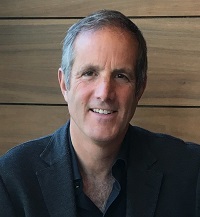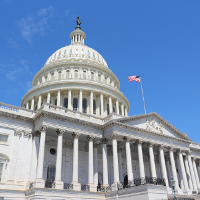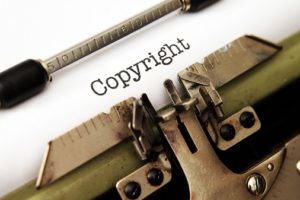 By Rachelle Mortimer & Grant Ossler*
By Rachelle Mortimer & Grant Ossler*
The Arts & Entertainment Advocacy Clinic at Antonin Scalia Law School recently filed an amicus brief in the Brammer v. Violent Hues case that is on appeal in the Fourth Circuit. The Clinic provides a unique opportunity for students interested in intellectual property and entertainment law. Each semester, students participating in the Clinic are able to gain practical experience working with clients and industry professionals on various projects related to copyright law and policy.
One organization that the Clinic often works with is Washington Area Lawyers for the Arts (WALA), which helps to provide legal services for local artists through volunteer attorneys who take on cases pro bono or at a reduced rate. By working with WALA to hold legal intake Clinics and take on pro bono cases, Clinic students are able to understand how copyright law affects individual artists. It is this understanding that led the Clinic to file the amicus brief in order to protect the rights of artists and prevent a dangerous expansion of the fair use defense to infringement.
Working with local attorneys from Protorae Law, students from the Clinic drafted portions of the amicus brief to explain how the U.S. District Court for the Eastern District of Virginia eviscerated the meaning and analysis of fair use under the Copyright Act.
Case Background
In 2016, the owner of defendant Violent Hues found a photograph online, copied it, cropped it, and posted it on a website that his organization created for its annual film festival. The photo in question was first posted to the photographer’s personal website, as well as to several online image-sharing websites. Violent Hues created the website to guide festival goers and provide information about the local area for filmmakers and festival attendees.
The owner of Violent Hues claimed he did not see a copyright notice on the photo when he used it, believing the photo was “a publicly available photograph.” Plaintiff Russell Brammer sent a demand letter, and upon receipt of the letter, Violent Hues removed the photo from its website. Brammer brought suit against Violent Hues claiming two causes of action: (1) copyright infringement under 17 U.S.C. § 504(b), and (2) removal and alteration of copyright management information under 17 U.S.C. § 1202.
District Court Decision
Brammer did not respond to arguments regarding count two, therefore the district court considered that claim abandoned. The district court granted summary judgment in favor of Violent Hues on count one, deeming the use of the photo was fair use per the Copyright Act. Fair use is codified in the Copyright Act and guides us through four factors of consideration when conducting an analysis to determine whether a use is a fair use. These factors are:
(1) The purpose and character of the use, including whether such use is of a commercial nature …; (2) the nature of the copyrighted work; (3) the amount and substantiality of the portion used in relation to the copyrighted work as a whole; and (4) the effect of the use upon the potential market for or value of the copyrighted work.
17 U.S.C.§ 107.
Unfortunately, the district court eviscerated any meaning to fair use under copyright law. In its examination of purpose and character, the district court determined Violent Hues’ use was “transformative in function and purpose” because Violent Hues’ use of the photo was informational: “to provide festival attendees with information regarding the local area.” The district court distinguished this from Brammer’s use, which was “promotional and expressive.” Additionally, the district court determined the use was non-commercial because the photo was not used for advertising or to generate revenue. Regrettably, this is as far as the transformative analysis went.
In the district court’s analysis of the second factor, fair use weighed in favor of Violent Hues again because the photo was factual in nature and “fair use is more likely to be found in factual works than in fictional works.” The district court acknowledged that Brammer incorporated creative elements in his photo (e.g., lighting and shutter speed), but ultimately held that because it was a “factual depiction of a real-world location,” it was purely factual content. The district court determined this without regard to creativity, though. The photo itself is a time-lapse photo of the Adams Morgan neighborhood of Washington, D.C.
In examining the third factor of fair use, the district court determined that Violent Hues did not use any more of the photo than was necessary, and therefore this factor substantiality weighed in favor of Violent Hues. Keep in mind, though, that the photo in question was merely cropped.
Lastly, the district court concluded that because there was no evidence that Violent Hues’ use had any effect on the potential market for the photo, the fourth factor also weighed in favor of Violent Hues. To support its decision, the district court stated: “The Court’s task is to determine whether the defendant’s use of the plaintiff’s works would materially impair the marketability of the works and whether it would act as a market substitute.” The district court arrived at this decision despite Brammer testifying he had been compensated for the photo six times—two times after Violent Hues’ infringement.
And thus, we have summary judgment for Violent Hues under a non-comprehensive fair use analysis.
Amicus Brief Summary and Commentary
The purpose of the Clinic’s amicus brief is to assist the court with regard to a proper, comprehensive fair use analysis, and to prevent the possible harm that an overly broad interpretation of the fair use defense could bring.
In examining the first factor of fair use, “purpose and character”, the district court unfortunately dedicated approximately two sentences to the analysis of why Violent Hues’ use was transformative in “function and purpose.” The district court simply stated that because the use was “informational,” and not “expressive” like Brammer’s use, the use was thus transformative. The proper examination requires looking at whether the new use adds something new “with a further purpose or different character.” As Judge Leval stated in his seminal article, Toward a Fair Use Standard, a different purpose or character, constituting a transformative use, is one that “alter[s] the first with new expression, meaning, or message,” and “employs the quoted matter in a different manner or for a different purpose from the original, thus transforming it.”
The district court failed to understand that Violent Hues’ use merely superseded Brammer’s. Violent Hues cropped the top and bottom of Brammer’s photo then posted it to its website with the purpose of showing the Adams Morgan neighborhood. A “wholesale taking” of the heart of the work, without adding additional value or meaning, is not transformative. The erroneous conclusion reached on this first factor destroys any meaning to transformative use and effectively erodes the exclusive rights held by copyright owners. To further illustrate this point, if the district court’s analysis is upheld, an author who writes a book regarding his life as president and his controversial pardon of a former political figure would have no recourse against a film producer who takes the author’s content verbatim and makes it into a movie. Why? Because the book is merely “informational,” while the film is “expressive” and thus transformative in function and purpose.
The district court’s opinion also addressed the role of “good faith” in a fair use defense and concluded that Violent Hues had acted in good faith when it found Brammer’s photo online because a copyright notice was not attached. This is not the law. Copyright protection under U.S. law is automatic from the moment of creation and notice need not be affixed to the published work for that protection to adhere. The good faith of alleged infringers is not frequently considered in fair use cases because “good faith” is not a statutory factor in the fair use analysis, and this has led to a lack of clear precedent on this point.
We proposed in our brief that if an alleged infringer acts in good faith, the court should neither weigh this factor for or against a finding of fair use. However, if an alleged infringer is shown to have acted in bad faith, using an artist’s work with the purpose of usurping the exclusive rights under 17 U.S.C. § 106, it should be weighed against a finding of fair use. Good faith should not weigh in favor of fair use because the purpose of the fair use defense is to protect First Amendment rights and allow limited uses of copyrighted works. On the other hand, bad faith should be weighed against a finding of fair use because trying to usurp an artist’s rights or using a work without paying for it does not align with the important purposes of the fair use defense.
Violent Hues did not act in good faith, but it also did not act in bad faith. Thus, the good faith factor should not have been considered at all in this case. A copyright notice is not required for a photograph to be protected. If the court allows Violent Hues’ lack of education on copyright law to be considered good faith, this would encourage internet users to remain ignorant of copyright law and infringe upon works more frequently. For these reasons, we asked the Fourth Circuit to clarify the role of the good faith factor in a fair use analysis.
The other factor our amicus brief addressed was the second factor of the fair use analysis. Digging into this factor, we asked that the court to clarify the analytical framework for evaluating the nature of the copyrighted work. In clarifying this framework, parties and other courts will be better able to determine when factual elements of copyrighted works are outweighed by the creative elements of such works. Brammer’s photo, specifically, is an appropriate vehicle for this since it combines creative and factual elements. Our brief articulates that a court can borrow from more familiar concepts of trademark’s nominative fair use and the defense of necessity to the tort of trespass on real property (noting that the prevailing theory of copyright is a property). Such theories provide for a defense on the basis of “necessity.”
In this analysis of necessity, one would believe that content in the factual lexicon would lean strongly toward a finding of fair use for the alleged infringer. However, where the use of the copyrighted work is not necessary to convey the same factual content, the motivation behind copyright law should be preserved—rewarding and protecting creativity. Brammer’s photo was a time-lapse photo of the Adams Morgan neighborhood; it was creative and depicted a factual setting. However, the mere fact that an original, creative work is factual does not imply that others may freely copy it.
The district court improperly analyzed this second factor in light of Violent Hues’ use of the photo, and not the intended use of the content creator, giving greater weight to the fact that the photo depicted a real-world location. We argued that this analysis “sanctions abuse of the fair use defense to appropriate copyrighted material so long as the user can claim that a factual element within the whole was the reason for their unauthorized appropriation.” The appropriate analysis centers on the concept of protecting creative elements while simultaneously not limiting the public’s use of facts. In the case at hand, Violent Hues’ use of Brammer’s photo to convey factual information about Adams Morgan was unnecessary because to convey the same message, and arguably in a more factual manner, Violent Hues could have driven to Adams Morgan to take its own snapshot of the neighborhood.
Finally, the district court’s determination that prior publication weighs in favor of a fair use is erroneous. As Patry on Fair Use provides: “The fact that a work is published does not mean that the scope of fair use is broader.” To state that publishing a copyrighted work broadens the scope of fair use renders the exclusive rights afforded to copyright owners null. Such a holding undermines the “special reward” of copyright protection and discourages creation of works—in stark contrast to the affirmative statements on copyright in the U.S. Constitution. Publication should be viewed as neutral until it can be considered under the fourth factor of the fair use analysis, wherein a court examines the impact of the alleged infringing use on the market for the copyrighted work. The district court’s simplistic approach to its analysis allows for parties to undermine the core purposes of copyright protection and, again, eviscerates a proper fair use analysis.
It is our hope that our amicus brief will help guide the Fourth Circuit as it assesses the extent of the fair use doctrine in the digital age. We are especially thankful to Antigone Peyton and David Johnson of Protorae Law, Terrica Carrington of the Copyright Alliance, and Professor Sandra Aistars of the Arts & Entertainment Advocacy Clinic for the opportunity to work on this important issue. To read our amicus brief, please click here.
*Rachelle Mortimer and Grant Ossler are students at Antonin Scalia Law School, where they study under Professor Sandra Aistars in the Arts & Entertainment Advocacy Clinic.


 By Liz Velander
By Liz Velander The U.S. Copyright Office released its long-awaited report on
The U.S. Copyright Office released its long-awaited report on  By Rachelle Mortimer & Grant Ossler*
By Rachelle Mortimer & Grant Ossler* Mason Law’s Arts & Entertainment Advocacy Clinic filed comments today with the U.S. Copyright Office detailing the frustrations and futilities experienced by everyday artists as they struggle with the DMCA system to protect their copyrights online.
Mason Law’s Arts & Entertainment Advocacy Clinic filed comments today with the U.S. Copyright Office detailing the frustrations and futilities experienced by everyday artists as they struggle with the DMCA system to protect their copyrights online.